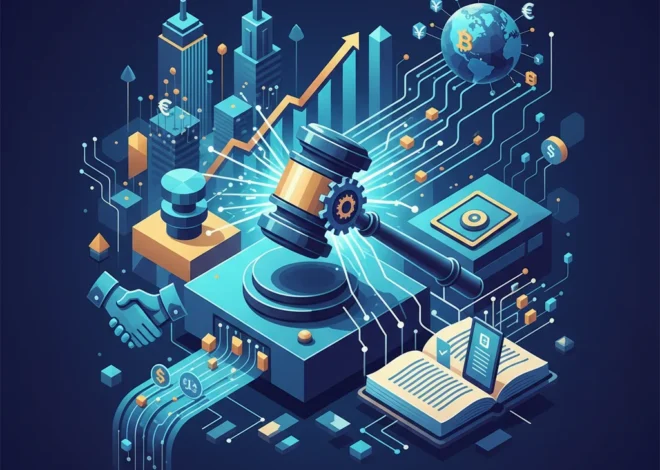
The Economy’s Green Light: Why Cooling Inflation is Fueling a Tech and AI Revolution
If you’ve glanced at the headlines recently, you might have seen the news: U.S. stocks are on a tear, hitting one record high after another. It’s a significant turnaround from the market jitters we saw earlier this year. But beyond the numbers on a stock ticker, what does this actually mean for those of us building, funding, and working in the technology sector? The answer is: a lot.
The recent market rally isn’t just random optimism. It’s a direct reaction to a crucial piece of economic data: inflation is cooling down. According to a recent report, equities have surged to new records, driven by softer-than-expected inflation figures that have investors breathing a collective sigh of relief (source). This might sound like dry financial news, but it’s the starting pistol for the next wave of tech innovation, impacting everything from startup funding and AI development to the job market for software engineers.
In this post, we’ll decode these economic signals and explore the profound ripple effects they have across the tech landscape. We’ll break down why cooling inflation is the fuel the tech engine needs and what opportunities this new environment creates for developers, entrepreneurs, and tech leaders.
The Domino Effect: From Inflation Data to Your Next Big Project
To understand why Wall Street’s good mood matters to Silicon Valley (and every tech hub in between), we need to connect a few dots. The chain reaction looks something like this:
- Inflation Cools Down: The Consumer Price Index (CPI), a key measure of inflation, came in lower than anticipated. This signals that the aggressive interest rate hikes from the Federal Reserve are working to stabilize the economy.
- The Fed Can Ease Up: With inflation under control, the pressure on the central bank to keep interest rates high diminishes. The market now anticipates that the next move will be an interest rate cut, not another hike.
- Capital Becomes Cheaper: Interest rates are essentially the “cost of money.” When they go down, it becomes cheaper for businesses to borrow money for expansion, for venture capitalists to raise funds for investment, and for large corporations to finance ambitious new projects.
- Growth and Innovation Get Funded: For the tech world, which thrives on forward-looking investments, this is a game-changer. Cheaper capital means more funding for R&D, more hiring for programming and engineering roles, and a greater appetite for risk-taking—the very essence of innovation.
Think of it this way: for the past two years, the tech industry has been in a “cash is king” environment. High interest rates made safe investments (like government bonds) attractive and made speculative, long-term bets (like funding a pre-revenue AI startup) seem risky and expensive. Now, the pendulum is swinging back. The new economic climate encourages investment in the future, and technology is the ultimate future-facing industry.
The Chip War Just Shifted Gears: Why Your Next Car is on the Geopolitical Frontline
How the Economic Shift Impacts a Tech Startup: A Tale of Two Environments
To make this tangible, let’s compare how a hypothetical tech startup might fare in a high-rate environment versus the low-rate one we’re heading towards. The difference is stark and affects everything from valuation to hiring.
| Factor | High-Interest Rate Environment (The Recent Past) | Lower-Interest Rate Environment (The Emerging Future) |
|---|---|---|
| Venture Capital Funding | VCs are cautious, deploying less capital. Funding rounds are smaller, valuations are down (“down rounds”), and diligence is intense. Focus is on profitability and cash preservation. | VCs are more aggressive, raising larger funds and deploying capital more freely. Valuations increase, and the focus shifts back to growth, user acquisition, and market share. |
| Startup Valuation | Future cash flows are heavily discounted, leading to lower present-day valuations. A SaaS company’s value might be 5-7x its annual revenue. | Future growth is valued more highly. The same SaaS company might be valued at 10-15x revenue or more, making it easier to raise capital without significant dilution. |
| Hiring & Talent | Hiring freezes and layoffs are common. Companies prioritize efficiency and lean teams. Competition for jobs is high. | Aggressive hiring resumes. Companies compete for top engineering and machine learning talent, offering higher salaries and better benefits to fuel expansion. |
| Corporate Strategy | Focus on survival, extending runway, and achieving profitability. R&D budgets for speculative projects (e.g., experimental AI) are often cut. | Focus on aggressive growth, M&A, and market capture. Investment in long-term, ambitious R&D projects is greenlit. |
The Sectors Primed for Explosive Growth
With capital flowing more freely, certain technology sectors that are particularly capital-intensive or built on long-term growth narratives are set to benefit the most. Here’s where we can expect to see a surge of activity.
1. Artificial Intelligence and Machine Learning
Generative AI is incredibly expensive. It requires massive amounts of cloud computing power for training models, vast datasets, and teams of highly specialized (and highly paid) researchers and engineers. A lower-cost capital environment is like pouring gasoline on the AI fire. We can expect to see:
- More Ambitious Models: Startups and big tech alike will have the funding to pursue next-generation foundation models that are more powerful and multi-modal.
- Hardware Innovation: The race to build more efficient chips and data center infrastructure for machine learning will accelerate.
- Niche AI Applications: More funding will flow to startups applying AI to specific industries like drug discovery, financial modeling, and logistics.
2. Enterprise SaaS and Cloud Infrastructure
SaaS and cloud computing companies are often valued based on a multiple of their recurring revenue. As we saw in the table, these multiples expand when interest rates fall because their predictable, long-term revenue streams become more valuable. This environment encourages enterprise customers, feeling more confident about the economy, to sign larger, multi-year contracts. They will be more willing to invest in digital transformation projects, boosting demand for everything from CRM software to cloud storage and computing services.
3. Cybersecurity
Innovation and expansion inevitably lead to new vulnerabilities. As companies adopt new AI tools, migrate more data to the cloud, and connect more devices, their digital attack surface grows exponentially. Cybersecurity is no longer a discretionary IT expense; it’s a fundamental cost of doing business and a prerequisite for innovation. A thriving tech economy means a thriving cybersecurity sector, with increased investment in areas like:
- AI-powered threat detection.
- Cloud security posture management (CSPM).
- Identity and access management (IAM) for complex software ecosystems.
The Digital Ghost: Why OpenAI's Ban on MLK Deepfakes Is a Defining Moment for AI Ethics
4. Automation and Robotics
When the economic outlook is positive, companies shift their thinking from short-term survival to long-term efficiency and scalability. This is the perfect breeding ground for investment in automation. Whether it’s robotic process automation (RPA) to streamline back-office tasks or physical robots for manufacturing and logistics, businesses will be more willing to make the upfront capital investment for a long-term payoff in productivity. This is a huge opportunity for startups and established players in the automation space.
What This Means for You: Actionable Takeaways
This isn’t just abstract economic theory. These shifts have real-world implications for your career and your business.
- For Developers and Tech Professionals: The job market is likely to heat up. Companies will be competing for talent to build out their ambitious roadmaps. This is an excellent time to hone skills in high-demand areas like machine learning, cloud architecture, and cybersecurity. Your leverage in salary negotiations may increase.
- For Entrepreneurs and Startups: The fundraising winter is thawing. If you’ve been bootstrapping or waiting for the right moment to raise capital, that moment is approaching. Refine your pitch, emphasize your growth potential, and get ready to talk to investors who are once again looking for the next big thing. The market hitting a series of new records is a powerful psychological signal to VCs.
- For Tech Leaders and Managers: It’s time to switch from a defensive to an offensive mindset. Re-evaluate your budget for R&D and strategic projects. If you put innovation on the back burner during the downturn, now is the time to reignite those initiatives and invest in the tools and talent that will give you a competitive edge.
Caught in the Crossfire: Why Europe's Tech Future is Hostage to the US-China Mineral War
Conclusion: Seizing the Momentum
The headlines about stock market records are more than just noise; they are a barometer of economic sentiment that has a direct and powerful impact on the technology industry. The cooling of inflation is unlocking the capital and confidence needed to fuel the next cycle of growth and innovation.
From funding the next generation of AI to accelerating the adoption of SaaS and automation, the entire tech ecosystem is poised to benefit. The challenges of the past couple of years have forged leaner, more efficient companies. Now, with the economic headwinds turning into tailwinds, those companies are ready to build the future. The green light is on—it’s time to hit the accelerator.


